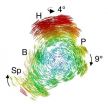(Press-News.org) ANN ARBOR, Mich. — A primary reason that head and neck cancer treatments fail is the tumor cells become resistant to chemotherapy drugs. Now, researchers at the University of Michigan Comprehensive Cancer Center have found that a compound derived from the Indian spice curcumin can help cells overcome that resistance.
When researchers added a curcumin-based compound, called FLLL32, to head and neck cancer cell lines, they were able to cut the dose of the chemotherapy drug cisplatin by four while still killing tumor cells equally as well as the higher dose of cisplatin without FLLL32.
The study appears this week in the Archives of Otolaryngology – Head and Neck Surgery.
"This work opens the possibility of using lower, less toxic doses of cisplatin to achieve an equivalent or enhanced tumor kill. Typically, when cells become resistant to cisplatin, we have to give increasingly higher doses. But this drug is so toxic that patients who survive treatment often experience long-term side effects from the treatment," says senior study author Thomas Carey, Ph.D., professor of otolaryngology and pharmacology at the U-M Medical School and co-director of the Head and Neck Oncology Program at the U-M Comprehensive Cancer Center.
That tumors become resistant to cisplatin is a major reason why head and neck cancer patients frequently see their cancer return or spread. It also plays a big role in why five-year survival for head and neck cancer has not improved in the past three decades.
FLLL32 is designed to sensitize cancer cells at a molecular level to the antitumor effects of cisplatin. It targets a key type of protein called STAT3 that is seen at high levels in about 82 percent of head and neck cancers. High levels of STAT3 are linked to problems with normal cell death processes, which allow cancer cells to survive chemotherapy treatment. STAT3 activation has been associated with cisplatin resistance in head and neck cancer.
Curcumin is known to inhibit STAT3 function, but it is not well-absorbed by the body. FLLL32 was developed by researchers at Ohio State University to be more amenable to use in people. The current study used the compound only in cell lines in the laboratory.
In the current study, researchers compared varying doses of cisplatin alone with varying doses of cisplatin plus FLLL32 against two sets of head and neck cancer cells: one line that was sensitive to cisplatin and one line that was resistant.
They found that FLLL32 decreased the activation levels of STAT3, sensitizing both resistant and sensitive tumor cells to cisplatin. Further, lower doses of cisplatin with FLLL32 were equally effective at killing cancer cells as the higher doses of cisplatin alone.
Separate studies suggest FLLL32 may not be well-absorbed by the body and researchers are developing a next generation compound that they hope improves on that. The U-M team plans to further study this newer compound for its potential as part of head and neck cancer treatment. Clinical trials using this compound are not currently available.
INFORMATION:
Head and neck cancer statistics: 36,540 Americans will be diagnosed with head and neck cancer this year and 7,880 will die from the disease, according to the American Cancer Society
Additional authors: Waleed M. Abuzeid, M.B.B.S.; Samantha Davis, B.S., M.D.; Alice L. Tang, B.A., M.D.; Lindsay Saunders, B.S.; J. Chadwick Brenner, M.S.E.; Emily Light, M.S.; Carol R. Bradford, M.D.; and Mark E.P. Prince, M.D., all from U-M; Jiayuh Lin, Ph.D., from the Nationwide Children's Hospital, Columbus, Ohio; James R. Fuchs, Ph.D., from The Ohio State University
Funding: National Institute of Dental and Craniofacial Research, Head and Neck Specialized Program of Research Excellence (SPORE) grant, National Cancer Institute, American Cancer Society
Disclosure: None
Reference: Archives of Otolaryngology – Head and Neck Surgery, Vol. 137, No. 5, pp. 499-507
Resources:
U-M Cancer AnswerLine, 800-865-1125
U-M Comprehensive Cancer Center, www.mcancer.org
Clinical trials at U-M, www.UMClinicalStudies.org
Curcumin compound improves effectiveness of head and neck cancer treatment, U-M study finds
Compound sensitizes resistant cells, allowing lower doses of chemotherapy
2011-05-20
ELSE PRESS RELEASES FROM THIS DATE:
My Wedding Favors Now Makes Winter Dreams Come True and Gives Wedding Guests a Scenic View
2011-05-20
Two packaging options. Two different price points. The same fine-quality wedding favor. MyWeddingFavors.com, a premier online retailer of wedding favors, baby shower favors and wedding accessories, announces the addition of "Simply Elegant" wedding favors and more from preferred vendor and nationally acclaimed favor designer Kate Aspen.
"As always, Kate Aspen's newly launched favors give brides what they absolutely want--spectacularly designed, top-quality favors at affordable prices. I think the idea of offering the same favor in two different packaging ...
Validating preschool programs for children with autism
2011-05-20
CORAL GABLES, FL (May 19, 2011)—Researchers from the University of Miami (UM) Department of Psychology participated in a multi-site study to examine different teaching models for children with Autism Spectrum Disorder (ASD). The study is one of the first to look at the fidelity of treatment models for preschoolers with autism. The findings are published online in the current issue of the journal Research in Autism Spectrum Disorders.
The report concludes the first phase of a four-year project to analyze the comparative efficacy of preschool programs for children with ...
Researchers connect electrical brain disturbances to worse outcomes following neurotrauma
2011-05-20
CINCINNATI—Electrical disturbances that spread through an injured brain like tsunamis have a direct link to poor recovery and can last far longer than previously realized, researchers at the University of Cincinnati Neuroscience Institute (UCNI) have found.
The disturbances, known as cortical spreading depolarizations, are short-circuits (electrical failures) that occur in a localized, or specific, area of injury and result in dampened brain waves. Because of their localization, the depolarizations are invisible in routine electroencephalography (EEG) exams. But they ...
UCSB localizing fruit, vegetable consumption doesn't solve environmental, health issues
2011-05-20
(Santa Barbara, Calif.) –– To David Cleveland, a professor of environmental studies at UC Santa Barbara, it seemed as though Santa Barbara County would be a great example of what many are advocating as a solution to the problems of a conventional agrifood network –– a local food system.
Santa Barbara County ranks in the top 1 percent of counties in the United States in value of agricultural products, with 80 percent of that value in fruits and vegetables. Farmers here grow some of the best fruits and vegetables in the country, and organic practices, farmers markets, and ...
Ensuring the safety of radiation therapy
2011-05-20
NEW HYDE PARK, NY -- Radiation oncologists took a blow in a series of front-page newspaper stories published last year on injuries that occurred nationwide in the delivery of radiation treatment. Radiation oncologists at North Shore-LIJ Health System responded to the public charge with a series of steps that will ensure that patients are protected at all points in the treatment process.
Louis Potters, MD, North Shore-LIJ's chairman of radiation medicine, and his colleagues designed a new program that seeks to improve the quality of complex processes by identifying and ...
Combating the C. diff terrorists on the loose in hospitals
2011-05-20
Just like intelligence agents watching for the real terrorists threatening to attack, monitoring healthcare worker adherence to mandatory hand-washing protocols via hand-washing squads in hospitals can go a long way to stop outbreaks of the opportunistic C. diff bacteria, says Irena Kenneley, an infection prevention and control expert and assistant professor of nursing from the Frances Payne Bolton School of Nursing at Case Western Reserve University.
Kenneley consulted on an analysis of a national hospital practices survey for the Association for Professionals in Infection ...
Caltech research helps paraplegic man stand and move legs voluntarily
2011-05-20
PASADENA, Calif.—A team of researchers from the University of California, Los Angeles (UCLA), the California Institute of Technology (Caltech), and the University of Louisville have used a stimulating electrode array to assist a paralyzed man to stand, step on a treadmill with assistance, and, over time, to regain voluntary movements of his limbs. The electrical signals provided by the array, the researchers have found, stimulate the spinal cord's own neural network so that it can use the sensory input derived from the legs to direct muscle and joint movements.
Rather ...
Strobe eyewear training may improve visual abilities
2011-05-20
DURHAM, N.C.—Strobe-like eyewear designed to train the vision of athletes may have positive effects in some cases, according to tests run by a team of Duke University psychologists who specialize in visual perception.
The eyewear has lenses that alternate between clear and opaque states, producing a strobe experience. Nearly 500 people participated in more than 1,200 training sessions and had their visual abilities tested before and after they wore the eyewear. They completed visual-motor tasks, such as catching and throwing a ball, as well as computer-based tests.
Once ...
Atomic-scale structures of ribosome could help improve antibiotics
2011-05-20
It sounds like hype from a late-night infomercial: It can twist and bend without breaking! And wait, there's more: It could someday help you fend off disease!
But in this case it's true, thanks to scientists from several institutions including the U.S. Department of Energy's Lawrence Berkeley National Laboratory. They derived atomic-scale resolution structures of the cell's protein-making machine, the ribosome, at key stages of its job.
The structures, developed primarily at Berkeley Lab's Advanced Light Source, reveal that the ribosome's ability to rotate an incredible ...
MovingOffCampus.com Provides Off Campus Housing Resource for College Students and Parents
2011-05-20
Recent updates to MovingOffCampus.com and the continued integration of new property partner listings has led to a fast, easy to use college apartment search engine for college students and parents with the largest database of available student apartments, condos and even homes for rent featured by school campuses, city and neighborhoods.
"The site can be incredibly useful for college student and parents, whether they're trying to get an idea of what the available housing is like after Freshmen year, or for students who are a little behind in finding the perfect ...
LAST 30 PRESS RELEASES:
Sleeping in on weekends may help boost teens’ mental health
Study: Teens use cellphones for an hour a day at school
After more than two years of war, Palestinian children are hungry, denied education and “like the living dead”
The untold story of life with Prader-Willi syndrome - according to the siblings who live it
How the parasite that ‘gave up sex’ found more hosts – and why its victory won’t last
When is it time to jump? The boiling frog problem of AI use in physics education
Twitter data reveals partisan divide in understanding why pollen season's getting worse
AI is quick but risky for updating old software
Revolutionizing biosecurity: new multi-omics framework to transform invasive species management
From ancient herb to modern medicine: new review unveils the multi-targeted healing potential of Borago officinalis
Building a global scientific community: Biological Diversity Journal announces dual recruitment of Editorial Board and Youth Editorial Board members
Microbes that break down antibiotics help protect ecosystems under drug pollution
Smart biochar that remembers pollutants offers a new way to clean water and recycle biomass
Rice genes matter more than domestication in shaping plant microbiomes
Ticking time bomb: Some farmers report as many as 70 tick encounters over a 6-month period
Turning garden and crop waste into plastics
Scientists discover ‘platypus galaxies’ in the early universe
Seeing thyroid cancer in a new light: when AI meets label-free imaging in the operating room
Neutrophil-to-lymphocyte ratio may aid risk stratification in depressive disorder
2026 Seismological Society of America Annual Meeting
AI-powered ECG analysis offers promising path for early detection of chronic obstructive pulmonary disease, says Mount Sinai researchers
GIMM uncovers flaws in lab-grown heart cells and paves the way for improved treatments
Cracking the evolutionary code of sleep
Medications could help the aging brain cope with surgery, memory impairment
Back pain linked to worse sleep years later in men over 65, according to study
CDC urges ‘shared decision-making’ on some childhood vaccines; many unclear about what that means
New research finds that an ‘equal treatment’ approach to economic opportunity advertising can backfire
Researchers create shape-shifting, self-navigating microparticles
Science army mobilizes to map US soil microbiome
Researchers develop new tools to turn grain crops into biosensors
[Press-News.org] Curcumin compound improves effectiveness of head and neck cancer treatment, U-M study findsCompound sensitizes resistant cells, allowing lower doses of chemotherapy



